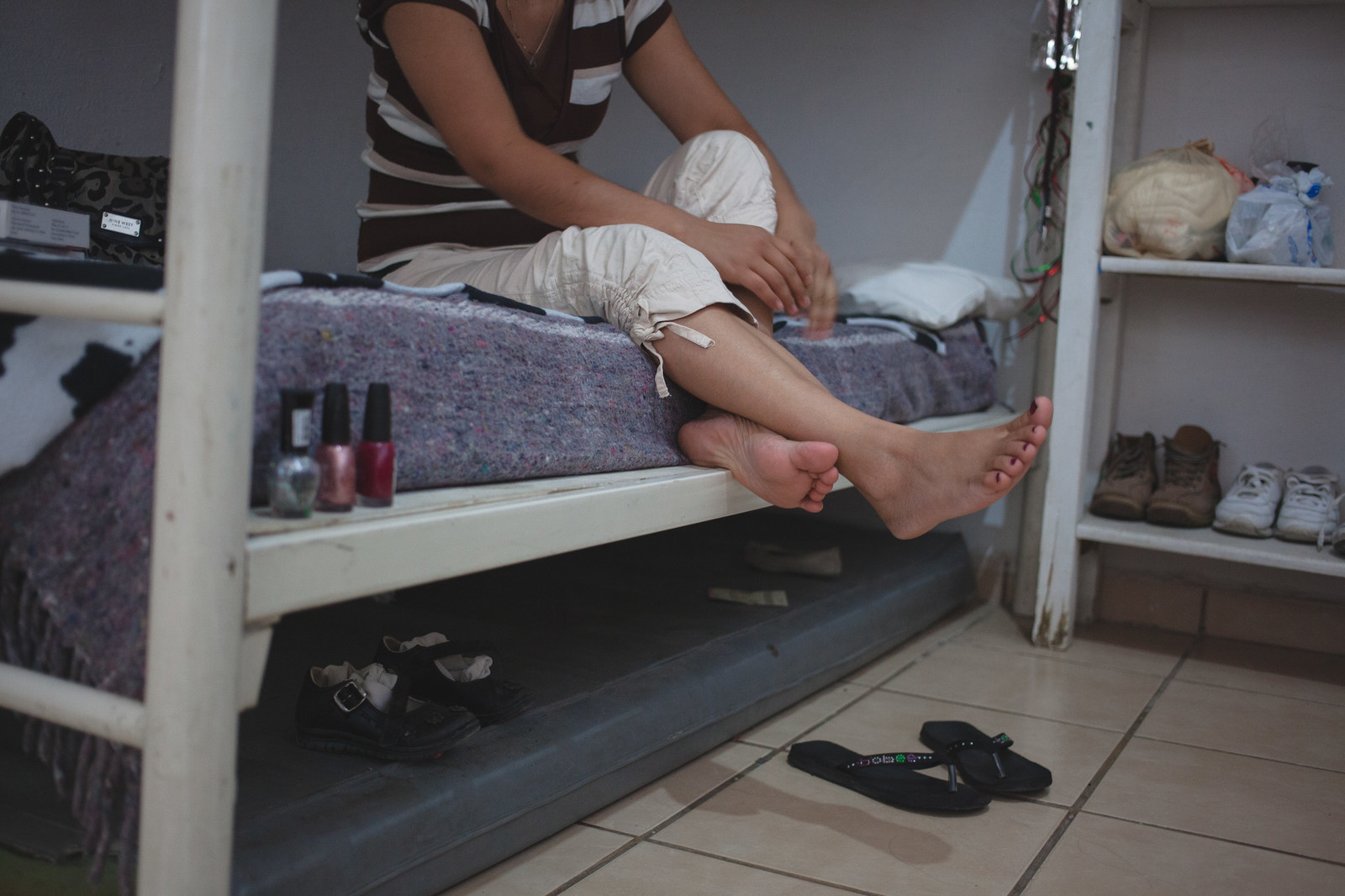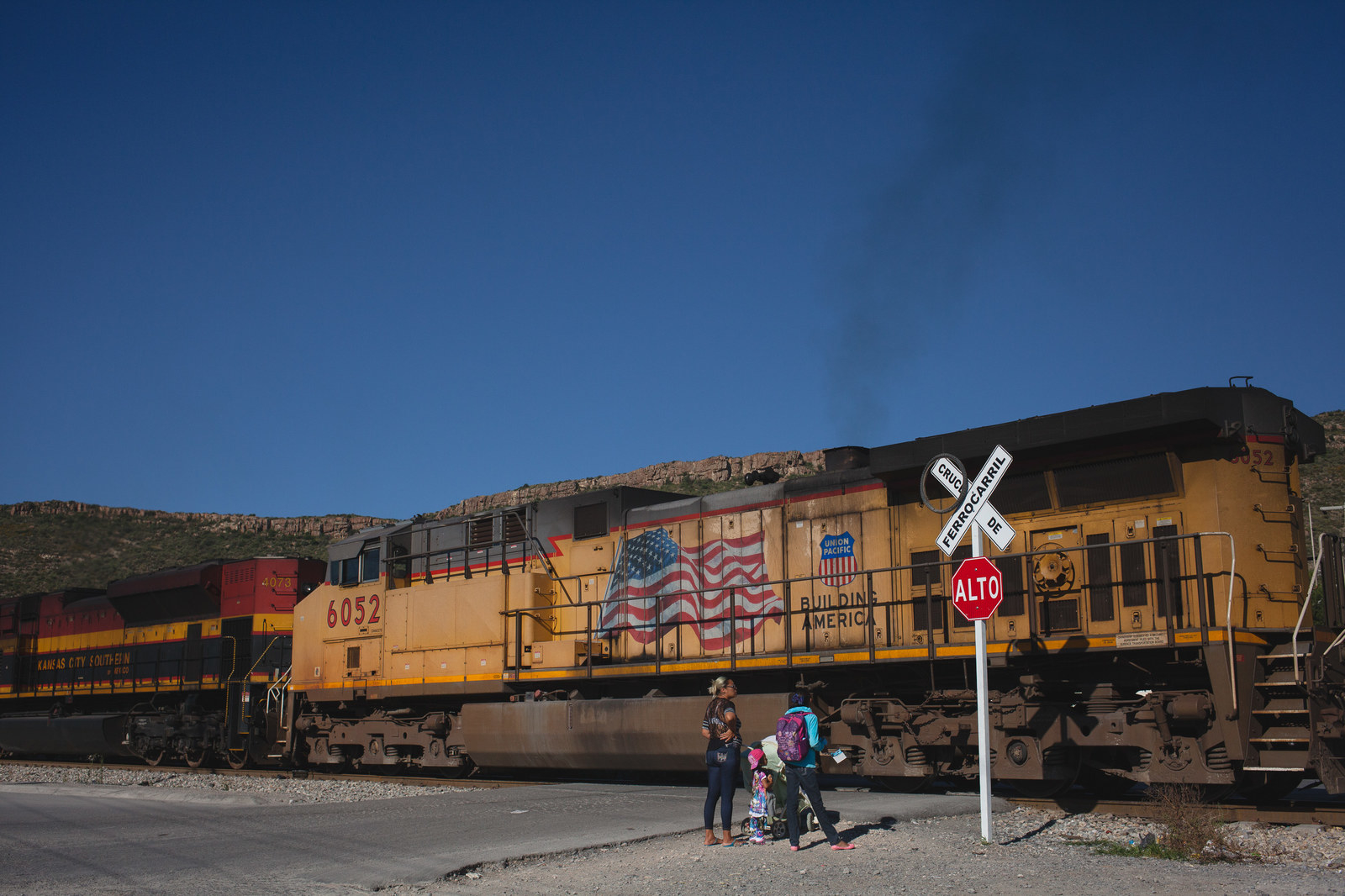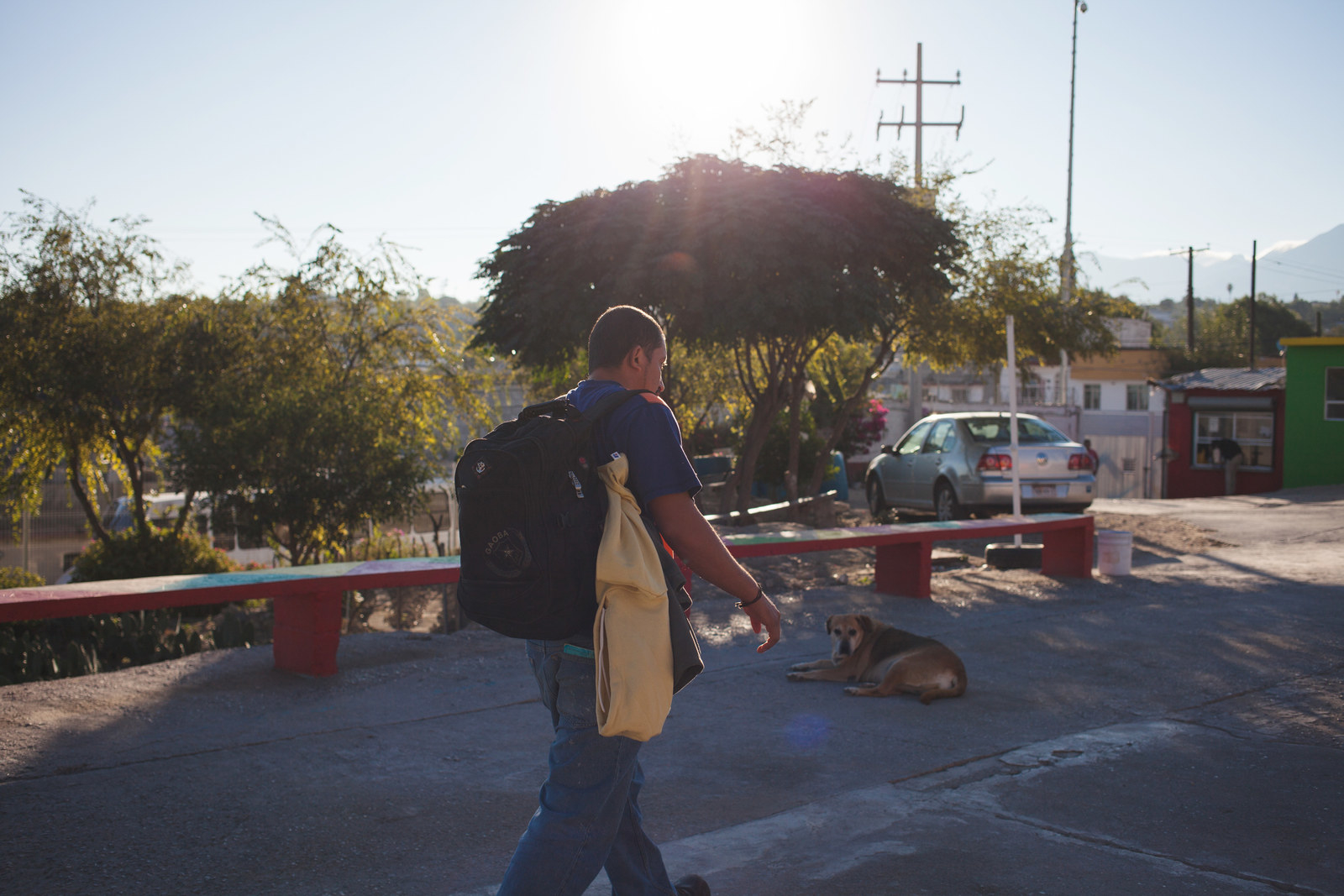
SALTILLO, Mexico — During their 1,475-mile journey across Mexico, Oscar and his girlfriend survived being shaken down by criminals, being held hostage by gangsters, and a ride atop a train from which hundreds of migrants have fallen to their death. It took them more than a month and was especially hard because they had their two young children with them — but neither faltered in their determination to get to the US.
It was agents from Mexico’s National Migration Institute that finally broke them down, and apart.
The family was detained in June near Allende, a small town not far from the US border, and put into separate holding cells inside a government-run detention center. No one informed them of their right to seek asylum, Oscar said, which he desperately wanted, having received death threats back in Honduras. After they learned about it from other detained migrants and began the process, he said, agents did all they could to dissuade them: It would take them at least five months, they were told, and during that time they wouldn't be able to leave the center or spend more than an hour a day together.
Conditions at the center were unsanitary, Oscar said: The cells reeked of urine, medical attention was limited, and food smelled like it had gone bad. When their baby fell ill, Oscar’s 17-year-old girlfriend, whose name he asked BuzzFeed News to withhold, gave up on her asylum claim. Several days later, with her child’s health improving, she changed her mind and tried to restart the process, Oscar said. By then it was too late.
Oscar is one of thousands of people fleeing Central America trying to get to the US, at a time when the issue has never been more hotly debated. As the US stands on the verge of an election whose results mean widely differing outcomes for immigration policy, it has also become a time to examine Barack Obama’s legacy. He has deported people in record numbers. And, analysts say, his administration has pressured Mexico to intercept undocumented migrants before they reach the US. That has led to mass detentions in Mexico, at times in deplorable conditions and of people who, analysts argue, could be recognized as refugees. And because the US still sends funds to Mexico to combat crime and strengthen the rule of law, activists say it remains to some extent accountable.

After more than 68,000 unaccompanied minors arrived in the US in early 2014, American lawmakers began to put pressure on Mexico to stem the flow. That summer, Mexico launched the Southern Border Program, or PFS, a plan to make its southern border less porous and to “protect migrants” moving up through its territory. The US said it intended to provide $86 million to Mexico for the task.
The program prompted a dramatic increase in detentions and deportations of migrants in Mexico, especially those from El Salvador, Honduras, and Guatemala. Last year, more than 181,000 migrants were deported from Mexico, up from 80,000 in 2013. More than 300,000 people have been detained since the program was launched.
But behind those numbers, analysts and migrants say, is an uglier story. The program has led to undocumented immigrants — legally allowed to be in Mexico since 2008 — being treated like criminals in overcrowded, jail-like government-run detention centers across the country. There, agents have at times tried to discourage migrants from seeking asylum even when their lives would be at risk were they to return home. It also led to a rise in extortions, kidnappings, and other crimes committed against migrants, many of these perpetrated by authorities, workers at migrant shelters across Mexico say. At least 2,500 employees of the National Migration Institute (INM) have been fired in the past three years following investigations into corruption and other irregularities.
The PFS has prompted migrants to take more circuitous, more expensive, and riskier routes than ever before in an attempt to avoid authorities, who some migrants say have extorted them during previous attempts to reach the US. Activists and migrant shelter staff say that authorities have also been involved in recent kidnappings. In an effort to avoid detection, migrants now travel in smaller, more vulnerable groups, jumping between buses and taxis, traveling in sealed-off vehicles, and walking for miles in between.
In a recent case, 51 migrants suffering from dehydration, along with four who had already died, were found inside an abandoned vehicle plastered with fake logos from the national postal service. In another, authorities discovered 121 migrants from Central America in the back of a cargo truck, showing signs of asphyxiation and dehydration.
One of the biggest concerns for activists is that authorities in Mexico are treating people who they think should be considered refugees as economic migrants and sending them back to dangerous situations. “I think the US should really feel guilty about it,” said Maureen Meyer of the DC-based Washington Office on Latin America (WOLA), speaking about the results of the PFS. “They’re not just outsourcing a migration situation, they’re outsourcing the responsibility of protecting refugees,” she said.
The US has funded broader anti-crime initiatives in Mexico, under the Merida Initiative, which has seen Washington give its neighbor $2.5 billion since 2008 to institutionalize the rule of law and support human rights. Last October, the US withheld part of these funds out of concern for the country’s human rights record. A State Department official said that at the time they concluded they “did not have sufficient information to address all the requirements” of a report that assesses human rights, called the 2015 Fifteen Percent Report. That same year, the State Department issued its annual human rights country report, which cited unlawful killings, torture, and disappearances carried out by authorities as some of the most pressing concerns, as well as abuses committed against migrants, including immigration agents failing to “screen migrants properly for refugee status.”
But earlier this month, despite evidence of ongoing abuses by authorities, the State Department moved to release $2.4 million of the retained funds. “We concluded the government of Mexico is meeting the criteria stipulated by the law,” said State Department spokesperson John Kirby, because the country has “launched an ambitious effort to modernize and reform its law enforcement and justice system.” Kirby admitted that the US was nonetheless still concerned about Mexico’s track record. “Human rights challenges remain,” he said.
As Americans prepare to go to the polls and usher in a new president, the question arises: Should their tax dollars be sent to Mexican authorities while their ranks are investigated, and at times imprisoned, for human rights abuses, particularly those affecting one of the country’s most vulnerable populations?

When Y. lost her 15-hour-a-day job at a tiny bookshop in Guatemala City last year, she grew anxious. One of nine siblings, she was responsible for sending money home to her family in the countryside. Her brother had recently been killed in a botched robbery, and her father, an alcoholic, did little to keep the clan afloat. An avid reader, Y., 18, still laments having been forced to quit school.
Y., who requested that only her middle initial be used for fear of reprisals from criminals who control Mexico’s northern border, played with several nail polish bottles as she sat cross-legged on the bottom bunk of the women’s dorm at the Saltillo shelter. After the housekeeping jobs she picked up ran out, Y. said, she became desperate. Unlike in El Salvador and Honduras, where criminals force impoverished youth to join their gangs, the main reason for Guatemalans to leave is unemployment. When a relative called Y. and offered to “take her north,” she didn’t think twice.
Aware of the risks she would face on her journey, especially the high incidence of sexual assault, the freckled teenager went to a clinic near her parents' home to get a three-month contraceptive shot. Then she joined the group to begin the journey north.
Piled into a truck “like cows,” Y. and 16 other people bumped along unpaved, unlit roads on the Mexico–Guatemala border in mid-July. Migrants used to take a cargo train that cleaves Mexico from north to south, but the train has become harder to board — it makes fewer stops, walls have gone up along its tracks, and private security guards throw off any passengers they see, migrants say. Immigration agents focus their detention efforts along its route, too.
As morning came, the group quickly moved into three SUVs. They would switch into at least eight other vehicles before arriving in Monterrey, an industrial city in northeast Mexico. Each time, their smugglers threatened to leave them behind if they didn’t hurry, paranoid about being caught by authorities. Y. and the others were in a constant state of exhausting alertness.
They moved by night and washed themselves in the houses of strangers, paid off by smugglers, by day. The first car in their convoy served as a lookout for immigration checkpoints; using walkie-talkies, the smugglers would make sharp U-turns or simply force the migrants out of the cars and into the overgrowth by the road. There, they tumbled down steep, muddy ravines and sprinted through fields filled with prickly pears in an effort to sidestep immigration officers.
On at least one occasion, Y. and another woman were separated from the rest of the group for hours as they walked across fields at night trying to make their way back to the highway.
And they went without any food other than Chokis cookies — Y. gets nauseous thinking of them now — for days. She grew weak.
While the group took their final break before walking the last handful of miles to the border, a group of gang members belonging to the Zeta cartel started chasing them down. Y. ran across cacti, thick thorns puncturing her arms and legs and drenching her jeans and T-shirt with blood. She had run out of water and started to get dizzy from lack of sleep. About 20 minutes later, she came to a halt. After the most challenging month of her life, she had no fight left in her.
Y. curled up underneath a cactus and, seeing one of the gang members approaching, prayed to God to make her invisible. Then she felt a pull: The man had dug his hands into her hair and he began to drag her across the field of cacti. After a short walk, he forced her onto the ground and raped her.
For the next four days, Y. sat quietly at a Zeta safehouse, watching as gang members tortured other migrants.
“If we hear the mosquito nearby, we’ll kill you all,” one of the kidnappers said, referring to a helicopter used by immigration authorities to patrol the border desert.
After relatives in the US eventually paid Y.’s ransom, her kidnappers walked her to the train and made her promise never to come back to the area. As she jumped on the train, one of them pulled her down impulsively, and the tumble broke her clavicle. She finally made it back on and rode the train until several train employees caught her and took her to the nearest shelter, in Saltillo.

There was the case of the federal police officers who opened fire on civilians in the main square in Apatzingán, a town in western Mexico, last year. There was the episode, in 2014, in which soldiers executed 22 people in Tlatlaya, in the state of Mexico. And of course there was the disappearance of the 43 students who attended the Ayotzinapa teacher trainee school, in 2013, which garnered headlines around the world.
The State Department Country Report on Human Rights Practices published last year cited all of the above. It went on to list arbitrary detentions, threats against human rights defenders, and violence against migrants as part of the persistent concerns in Mexico. Even before the report was released, 81 US lawmakers had signed a letter to Secretary of State John Kerry expressing their concern over the “pattern of grave human rights violations in the country.”
Since then, human rights abuses have continued, and in some cases worsened. One glaring example is the crimes against migrants in transit through Mexico. Last month, the “72” migrant shelter in Tenosique, near the border with Guatemala, issued a public letter denouncing eight mass kidnappings of migrants. In some cases, the letter said, the local and federal police had been involved.
Analysts support this claim. “Too often, Mexican authorities fail to investigate and sanction these cases. In many others, they are involved in crimes,” concluded a report by WOLA, released in September.
The report cited several measures adopted by Mexican authorities to curb abuses, like the creation of a special unit for migrants at the attorney general’s office, but said these only exist on paper. “In practice, authorities have dragged their feet to make them operational,” said the report, which lists human trafficking, rape, and abuse of authority as some of the most common crimes against migrants. It also predicted that 2016 would be the year with the highest number of reported crimes against migrants in Coahuila state, where Saltillo is located, since 2013.
Migrant detention centers, too, are plagued with problems, a report published last month by the National Human Rights Commission, or CNDH, in Mexico revealed. These include overcrowding, a lack of beds, nonexistent women-only areas, bans on visitors, and a shortage of translators for non-Spanish-speaking migrants. Some centers did not have medical staff and lacked proper security, the report continued.
According to a report by Doctors Without Borders published earlier this month, 9 out of 10 migrants are showing signs of anxiety or depression.
Mexican authorities deny that conditions for migrants, both in and out of detention centers, have worsened since PFS was launched. “That’s a very personal opinion. The institute doesn’t see it as such,” said Aurora Vega, director of press at the INM.
Asked about migrants' complaints that they are not informed about their right to request asylum, Vega said that those allegations were an “activist issue” and that “if there is an issue, we will gladly welcome any complaints.”
Reports of human rights violations filed at the INM have been on the rise. The institute received 650 complaints between between September 2014 and June 2015, up from 457 the previous term, according to the institute’s latest work report.
Employees at different centers had not received torture prevention training and had no knowledge of the Istanbul Protocol, an international guideline for documenting torture, the CNDH report concluded, which is especially concerning in a country where authorities have used torture on repeated occasions.
Yet, Mexican President Enrique Peña Nieto spoke about the importance of respecting migrants' rights during last month’s United Nations General Assembly. “We must place migrants, with their rights and dignity and well-being, at the center of the global debate,” he said.
Even as the US moves toward releasing the previously withheld funds, authorities there admit to being aware of the risks migrants face as they journey up through Mexico. When asked specifically about the increasing dangers migrants face in Mexico, a spokesperson at the State Department said the agency remains “concerned for the safety of all migrants.”

Luis Flores did not want to leave home. He lost his job as a bodyguard for a local congressman just as his 15-month-old son was beginning to talk. Without an income, the family would lose their home — the only inheritance Flores could leave his three children.
Flores needed $12,000 to pay for the house and knew that he could only earn that kind of money in the US. He was scared: When he made the journey across Mexico in 2008, criminals kidnapped him and stabbed his foot with an ice pick repeatedly, leaving it permanently numb. But, after listening to statements by Donald Trump, Flores decided he needed to get to the US before a wall was erected along its southern border.
In early August, Flores, who lost an eye after running into a tree branch when he was a toddler, left Guatemala to begin the 455-mile trek up through southern Mexico. For eight days straight, he walked along train tracks alone, carrying only a bag of bread, sleeping in the overgrowth and diving back into it whenever a train approached, a warning sign of immigration agents up ahead. Walking along the highway was not an option because of the mobile migration checkpoints.
Exhausted, he finally hopped on a passenger bus. As he began dozing off, the bus stopped at an immigration checkpoint and an agent jumped on and asked him where he was from. He was thrown in the “perrera,” or kennel, as migrants call the car used to transport them to detention centers.
Flores spent the next 18 days in a detention center in Veracruz, on the Gulf Coast. He became deeply anxious talking about his time there. It wasn’t the foul-smelling food, or the overcrowded quarters that left him sleeping on the cold floor — he could handle that. It was the lack of information that nearly sent him over the edge.
When would he be sent home? What was taking so long? Why were agents ignoring his pleas for information?
Authorities at the detention center, said Flores, did not inform him of his right to legal counsel or to request asylum. Others who have requested asylum have also said agents tried to dissuade them from pursuing it. And those who pursue it must wait with bated breath: Of the 3,486 asylum applications filed between January and June this year, 1,207 have been granted.
It’s harder than ever before,” said Flores. “Much harder.”


